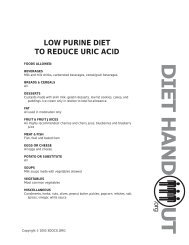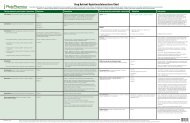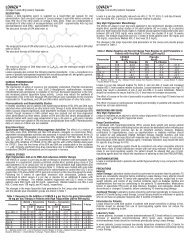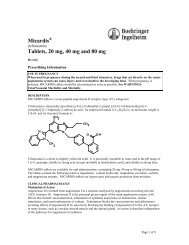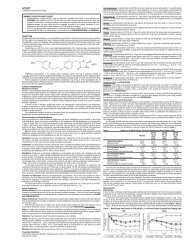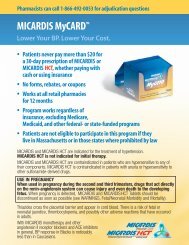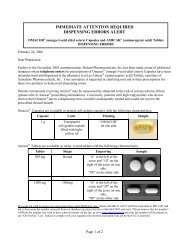Create successful ePaper yourself
Turn your PDF publications into a flip-book with our unique Google optimized e-Paper software.
Monograph<strong>Boswellia</strong> <strong>serrata</strong>Common Name: FrankincenseDescription and Constituents<strong>Boswellia</strong> <strong>serrata</strong> is a moderate to large branchingtree found in India, Northern Africa, and the MiddleEast. Strips of bark are peeled away, yielding agummy oleo-resin which contains oils, terpenoids,and gum. Up to 16 percent of the resin is essentialoil, the majority being alpha thujene and p-cymene.Four pentacyclic triterpene acids are also present, with ß-Boswellic acid being the major constituent.Extracts of this gummy exudate have been traditionally used in the Ayurvedic system of medicine asan anti-arthritic. These gum resins are also known as guggals. S. Nityanand et al showed the guggal ofCommiphora mukul to be an effective hypolipidemic agent, but it does not have the anti-inflammatory actionof the gum resin of <strong>Boswellia</strong> <strong>serrata</strong>.Mechanism of ActionAnimal studies performed in India showed ingestion of a defatted alcoholic extract of <strong>Boswellia</strong> decreasedpolymorphonuclear leukocyte infiltration and migration, decreased primary antibody synthesis, 1,2 andcaused almost total inhibition of the classical complement pathway. 3 In an in vitro study of the effects of ß-Boswellic acid on the complement system, the extract demonstrated a marked inhibitory effect on both theclassical and alternate complement systems. 4 An investigation of <strong>Boswellia</strong>’s analgesic and psychopharmacologiceffects noted that it “was found to exhibit marked sedative and analgesic effects” in these animals. 5In vitro testing revealed <strong>Boswellia</strong> specifically, and in a dose-dependent manner, blocks the synthesisof pro-inflammatory 5-lipoxygenase products, including 5-hydroxyeicosatetraenoic acid (5-HETE) andleukotriene B4 (LTB4), 6 which cause bronchoconstriction, chemotaxis, and increased vascular permeability. 7Other anti-inflammatory plant constituents, such as quercetin, also block this enzyme, but they do so in a moregeneral fashion, as an antioxidant; whereas, <strong>Boswellia</strong> seems to be a specific inhibitor of 5-lipoxygenase. 8,9<strong>Boswellia</strong> has also been observed to inhibit human leukocyte elastase (HLE), which may be involved in thepathogenesis of emphysema. HLE also stimulates mucus secretion and thus may play a role in cystic fibrosis,chronic bronchitis, and acute respiratory distress syndrome. 10,11It is known that non-steroidal anti-inflammatory drugs can cause a disruption of glycosaminoglycansynthesis which can accelerate the articular damage in arthritic conditions. 12-15 A recent in vivo study examined<strong>Boswellia</strong> extract and ketoprofen for their effects on glycosaminoglycan metabolism. <strong>Boswellia</strong> significantlyreduced the degradation of glycosaminoglycans compared to controls, whereas ketoprofen caused a reductionin total tissue glycosaminoglycan content. 16Clinical StudiesHuman clinical studies are woefully lacking for this substance, and need to be conducted to betterelucidate its effects in humans, as well as to determine optimal dosing. Animal and in vitro studies suggest it isuseful for many inflammatory and bronchoconstrictive conditions.Page 306 Alternative Medicine Review ◆ Volume 3, Number 4 ◆ 1998Copyright©1998 Thorne Research, Inc. All Rights Reserved. No Reprint Without Written Permission
<strong>Boswellia</strong> <strong>serrata</strong>Leukotrienes are suggested to play a role in the inflammatory process of ulcerative colitis. <strong>Boswellia</strong> extract(350 mg three times daily) was compared to sulfasalazine (1 g three times daily) in ulcerative colitis patients.Patients on the <strong>Boswellia</strong> extract showed similar improvements as patients on sulfasalazine, although 82 percentof <strong>Boswellia</strong> patients went into remission, compared with 75 percent on sulfasalazine. 17DosageFor inflammatory or bronchoconstrictive conditions, 400 mg three times per day is suggested.ToxicityToxicity studies of <strong>Boswellia</strong> in rats and primates showed no pathological changes in hematological,biochemical, or histological parameters at doses of up to 1000 mg/kg. The LD 50 was established at >2 g/kg.References1. Sharma ML, Khajuria A, Kaul A, et al. Effects of salai guggal extract of <strong>Boswellia</strong> <strong>serrata</strong> on cellular andhumoral immune responses and leukocyte migration. Agents and Actions 1988;24(1-2):161-164.2. Sharma ML, Bani S, Singh GB, et al. Anti-arthritic activity of boswellic acid in bovine serum albumin-inducedarthritis. In J Immunopharmac 1989;6:647-652.3. H. Wagner. Search for new plant constituents with potential antiphlogistic and antiallergic activity. PlantaMedica 1989;55:235-241.4. Knaus U, Wagner H. Effects of boswellic acid of <strong>Boswellia</strong> <strong>serrata</strong> and other triterpenic acids on the complementsystem. Phytomedicine 1996;3:77-81.5. Menon MK, Karr A. Analgesic and psychopharmacological effects of the gum resin of <strong>Boswellia</strong> <strong>serrata</strong>. PlantaMedica 1971;4:332-341.6. Ammon HP, Mack T, Singh GB, Safayhi H. Inhibition of leukotriene B4 formation in rat peritoneal neutrophilsby an ethanolic extract of the gum resin exudate of <strong>Boswellia</strong> <strong>serrata</strong>. Planta Medica 1991;57:203-207.7. Robertson RP. Arachidonic acid metabolites relevant to medicine. In: Braunwald E, Isselbacher KJ, PetersdorfRG, et al, eds. Harrison’s Principles of Internal Medicine. 11th ed. New York. McGraw-Hill;1987:375.8. Safayhi H, Mack T, Sabieral J, et al. Boswellic acids: novel, specific nonredox inhibitors of 5-lipoxygenase. JPharmac Exp Ther 1992;261:1143-1146.9. Ammon HPT. Salai guggal – <strong>Boswellia</strong> <strong>serrata</strong>: from a herbal medicine to a specific inhibitor of leukotrienebiosynthesis. Phytomedicine 1996;3:67-70.10. Rall B, Ammon HPT, Safayhi H. Boswellic acids and protease activities. Phytomedicine 1996;3:75-76.11. Safayhi H, Rall B, Sailer ER, Ammon HPT. Inhibition by Boswellc acids of human leukocyte elastase. JPharmacol Exp Ther 1997;281:460-463.12. Lee KH, Spencer MR. Studies on mechanism of action of salicylates V: Effect of salicylic acid on enzymesinvolved in mucopolysaccharide synthesis. J Pharmacol Sci 1969;58:464-468.13. Palmowski MJ, Brandt KD. Effect of salicylate on proteoglycan metabolism in normal canine articular cartilagein vitro. Arthritis Rheum 1979;22:746-754.14. Dekel S, Falconer J, Francis MJO. The effect of anti-inflammatory drugs on glycosaminoglycan sulphation inpig cartilage. Prostaglandins Med 1980;4:133-140.15. Brandt KD, Palmoski MJ. Effect of salicylates and other non-steroidal anti-inflammatory drugs on articularcartilage. Am J Med 1984;77:65-69.16. Reddy GK, Chandraksan G, Dhar SC. Studies on the metabolism of glycosaminoglycans under the influence ofnew herbal anti-inflammatory agents. Biochem Pharm 1989;38:3527-3534.17. Gupta I, Parihar A, Malhotra P, et al. Effects of <strong>Boswellia</strong> <strong>serrata</strong> gum resin in patients with ulcerative colitis.Eur J Med Res 1997;2:37-43.Alternative Medicine Review ◆ Volume 3, Number 4 ◆ 1998 Page 307Copyright©1998 Thorne Research, Inc. All Rights Reserved. No Reprint Without Written Permission





